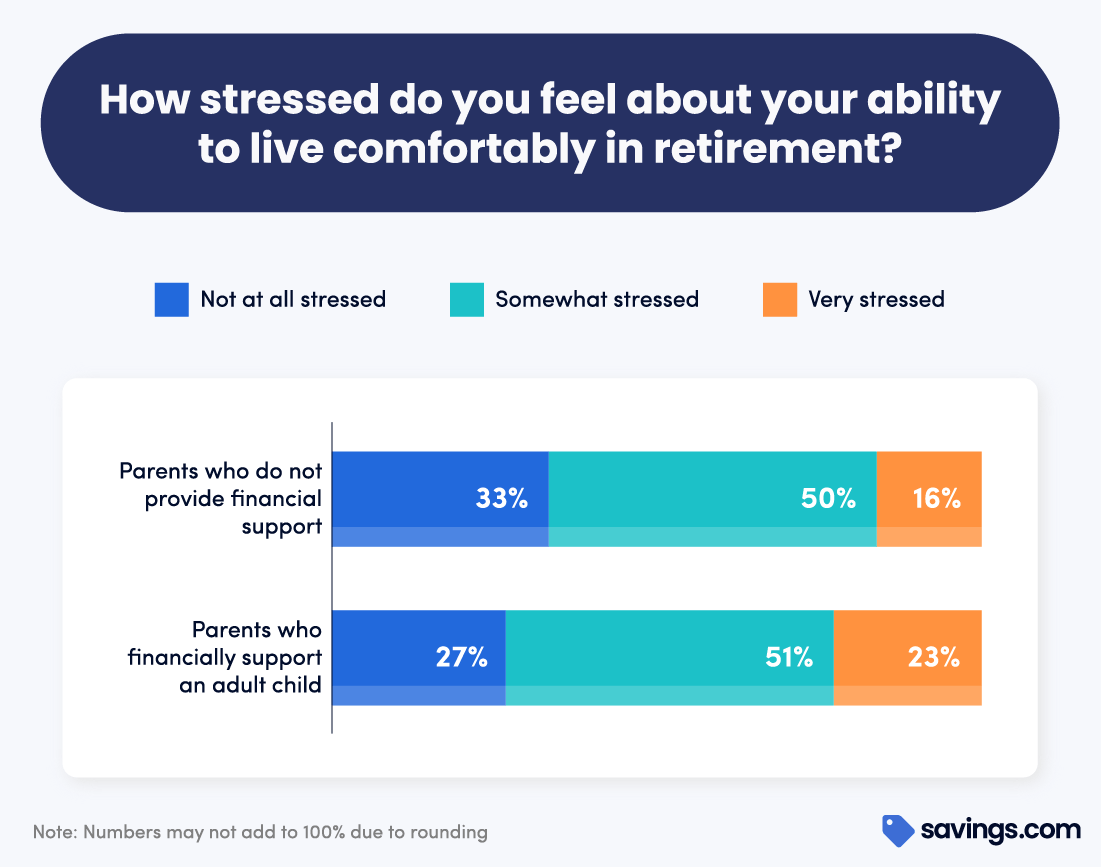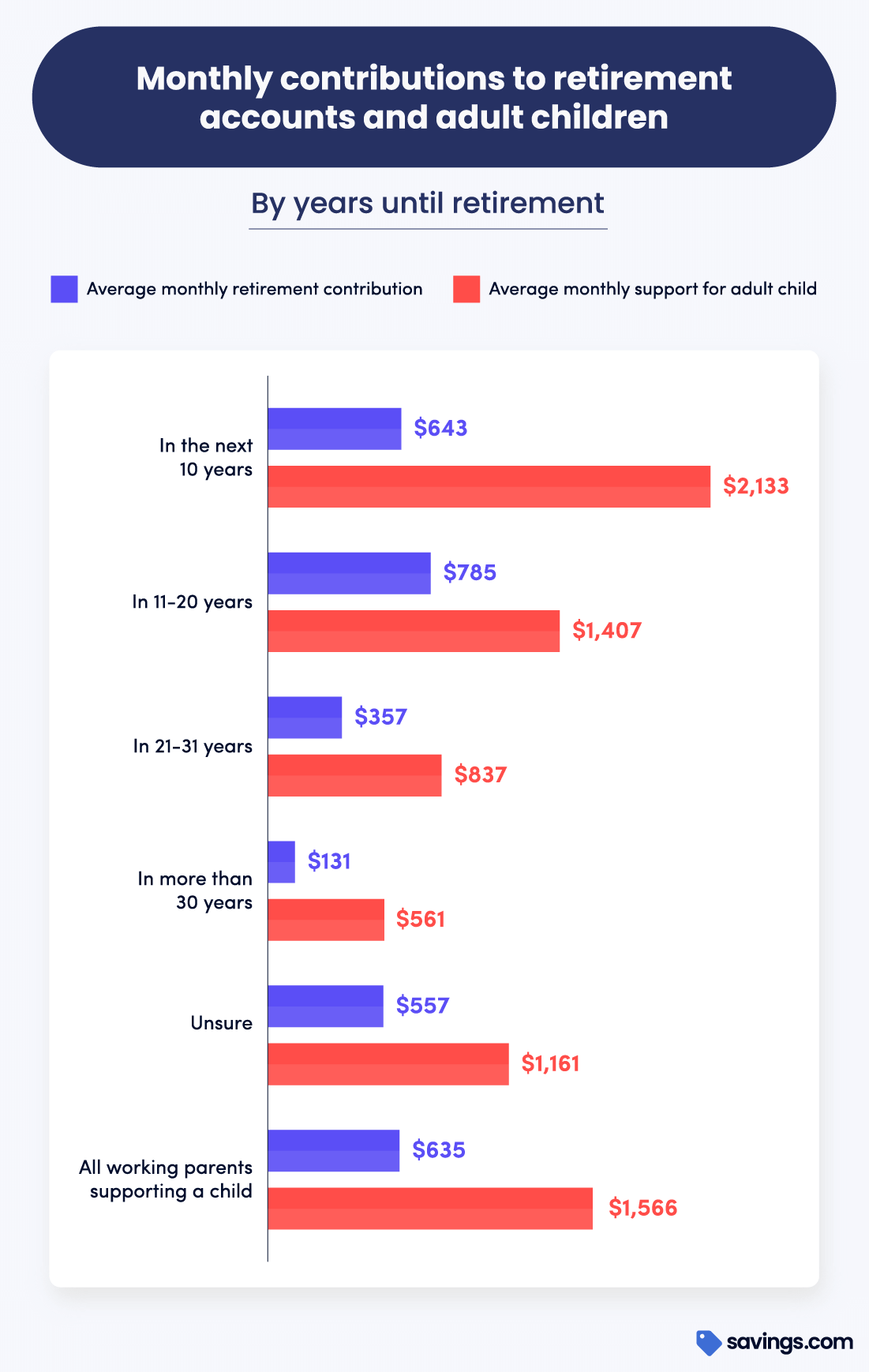
Last Updated: March 22, 2023
Leaving the nest seems to get harder and harder every year — and it’s not hard to understand why. Inflation continues to put pressure on consumers, while wages have stagnated. Student debts are rising without relief, and so are housing prices. The growing generational wealth gap means that for millions of Millennials and Gen-Z’ers, true financial independence is still out of grasp.
So it’s little wonder that parents of adult children are picking up the slack. Following up on research we began last year, we talked to about 1,000 Americans with at least one grown child to find out whether they provide financial support, how much, and how it’s affecting their ability to save for retirement.
Here’s a look at our key findings:
- Forty-five percent of parents of adult children provide financial support for at least one grown offspring. Thirty-one percent of kids getting financial help were millennials.
- Among those providing support, the average monthly total exceeds $1,400. Groceries, cell phones, and rent/mortgage are parents' most common spending categories.
- Twenty-one percent of parents providing support are helping with their kids’ student loan payments. On average, they contribute $245 a month to help relieve the debt.
- Parents ten years or less from retirement contribute the most monthly to their children — about $2,100 monthly. They only put $643 into their retirement accounts monthly.
Financial Service Savings: Financial and legal services such as Quickbooks, FamZoo, and Nolo offer coupons and discounts to help you better manage your money for less.
How many parents are still shelling out for grown-up kids?
According to our analysis, 51 percent of parents financially support an adult child, which largely tracks with our research from last year. This includes parents whose children may have a disability. Excluding those with a disability, 45 percent of parents are supporting at least one of their adult children.
However, given the economic turmoil and rampant inflation over the past year, it’s possible that a growing number of young adults may seek financial help from their parents, including moving back home. This was a growing trend in the early days of the Covid-19 pandemic. According to Pew’s analysis, 52 percent of 18- to 29-year-olds lived with their parents in 2020.
>> Related: Savings.com Inflation Calculator
Those 18-29 years old comprised 82 percent of the adult children supported by their parents in our study. However, nearly two in five adults receiving parental support are over 30.
Adult children who receive financial support from their parents, by children’s age group
| 18-19 | 13% |
| 20-24 | 52% |
| 25-29 | 17% |
| 30-34 | 8% |
| 35+ | 11% |
The majority of adult children receiving financial support were in the earliest years of adulthood: 66 percent of those receiving support were Gen Zers. Many people in this generation are still in college or just getting their footing in their careers, which means their income levels have much room to grow. Interestingly, 31 percent of adult children getting financial support from parents were millennials. The youngest people in this generation are around 27 years old.
Parental retirement plans by percentage who financially support an adult child
| Already retired | 34% |
| Next 10 years | 52% |
| 11-20 years | 63% |
| 21-30 years | 67% |
| 30 years+ | 58% |
| Not sure | 56% |
About one in three parents who are already retired (34 percent) are financially supporting a grown child. Many of these individuals are on fixed incomes, making supporting their children more challenging. However, parents further from retirement were more likely to support their adult children financially.
How much money are parents giving to their adult children?
On average, parents who support an adult child provide an average of $1,442 per month. Most frequently, parents are helping their kids with necessities like food and housing. More than three in four parents who support an adult child helped with groceries, while 63 percent covered their kid’s cell phone bill, and 56 percent gave money to cover their rent or mortgage.
Nearly 40 percent of financially supportive parents were helping kids pay for tuition, and one in five were helping their adult children make student loan repayments.
President Joe Biden’s August student loan forgiveness order, though it remains in limbo as it works through the court system, could relieve these parents. In addition to forgiving a portion of loans their children took out, the plan also includes forgiveness for some Parent PLUS loans. An estimated 600,000 parents take on these loans annually, and the average outstanding debt is $30,000.
If these parents stopped contributing money to student loan repayment, they’d have nearly $3,000 more annually to contribute to their retirement accounts.
Percentage of parents who financially support adult children
By spending category
| Category | Gen Z parents | Millennial parents | All parents | Average monthly contributions to children |
|---|---|---|---|---|
| Groceries or food | 78% | 75% | 76% | $172 |
| Cell phone | 70% | 48% | 63% | $62 |
| Rent or mortgage | 60% | 50% | 56% | $806 |
| Health insurance or healthcare | 67% | 15% | 50% | $168 |
| Leisure/vacations | 50% | 29% | 43% | $263 |
| Car | 44% | 33% | 41% | $342 |
| Tuition or other school expenses | 51% | 13% | 39% | $870 |
| Discretionary spending | 38% | 34% | 36% | $129 |
| Student loans | 23% | 18% | 21% | $245 |
| Credit cards | 16% | 19% | 17% | $198 |
| Investments | 14% | 8% | 12% | $398 |
Necessities like food and shelter aren’t the only things parents are providing for their grown-up children. Half of the parents of Gen-Z adults paid for vacations for their children, while 41 percent of all supporting parents help pay for their kids’ cars. Less frequently, parents pay for things like credit cards, discretionary expenses, or investments.
>> Save more: Debt vs Savings Calculator
Why do adults today need more financial support from their parents?
According to our study, about 57 percent of adult children who get help from their parents lived at home with them. Less than half of these adult children contributed financially to the household expenses, and their average monthly contribution is $186.
Average monthly contribution to household expenses
Among adults living at home with their parents
| Gen Zers | Millennials | All living with parents |
|---|---|---|
| $159 | $258 | $186 |
The number of young adults living at home has risen since the 1960s, especially among adults in their late twenties and early thirties. In 1960, about nine percent of people between 25 and 34 lived with their parents; by 2022, that figure was nearly 16 percent. What’s driving this upward trend? A growing generational wealth gap, increasing mortgage interest rates, growing student loan debts, and the economic crises of 2008 and 2020. These conditions have put many young adults on shaky financial ground, with little extra income to share with their families.
According to data from the Federal Reserve, the total generational wealth for Millennials nearly doubled during the pandemic. However, their wealth is still dwarfed by the Baby Boomer generation, which owns more than half the wealth in the U.S. The biggest driver of wealth for average Americans, homeownership, remains out of reach for many Millennials. By age 30, 51 percent of Baby Boomers were homeowners compared to 42 percent of Millennials.
Given the economic factors at play, it makes sense why young adults living at home may not contribute much to their household coffers.
Parents invest more in adult kids than their own retirement savings
Our research shows parents would be willing to go to great lengths to help support their children financially, even if that means putting themselves at financial risk. Only 19 percent of parents told us they wouldn’t be willing to do anything we asked about to support their adult children.
| Which of these would you be willing to do to support your adult child(ren)? Select all that apply. | |
|---|---|
| Live a more frugal lifestyle | 58% |
| Pull money from my savings or retirement account | 44% |
| Retire later | 33% |
| Take on debt | 25% |
| Come out of retirement | 16% |
| Refinance my home | 10% |
| None of the above | 19% |
Still, parents who currently support an adult child are more likely to report being stressed out about whether they’ll live comfortably in retirement.

Among working parents who support an adult child, the amount they save for their own retirement pales compared to what they spend on their child, even if retirement isn’t far off. Parents who plan to retire in the next decade contribute an average of $643 per month to their retirement accounts and spend more than $2,100 to support their grown children. If a parent is just ten years away from retirement, this could speak to the stability of their savings; in other words, maybe they spend more because they know they can afford it.

Most parents paying their adult child’s bills do not intend to provide support for the rest of their lives; only 19 percent said they never plan to withdraw their financial help. Just over half predict they’ll stop in the next couple of years.
And this is good news for parents’ economic well-being, especially for parents with a long retirement horizon. For example, if a typical parent in our study puts the amount they give to their children each month into a Roth IRA, they could significantly boost their retirement savings. Parents who won’t retire for another 20-30 years could generate over $176,000 in a Roth IRA.
Even parents with retirement dates approaching in the next ten years could still add $28,000 to their retirement coffers if they stopped supporting their adult children financially and invested that money instead.
How much could parents save if they invested the money they currently give to their adult children?
| Planned retirement date | Amount that could accrue in Roth IRA |
|---|---|
| Retire in the next 10 years | $28,195 |
| Retire in 11 - 20 years | $71,671 |
| Retire in 21 - 30 years | $176,195 |
Parenthood is an incredible responsibility that does not end when children turn 18. But while our research has consistently shown that the average parent of a grown child is generous, they perhaps could stand to learn better the lesson that it’s OK to put themselves first sometimes.
Methodology
We surveyed about 1,000 U.S. parents of adult children on whether they pay some of their children’s bills or provide other financial support. Our survey was conducted online in February 2023.
This year, our data distinguishes between adult children with disabilities, which may make it more difficult for them to live independently, and adult children without disabilities. Our analysis focused on parents who contribute financially to their adult children who don’t have disabilities.
To calculate what parents could save for retirement once they stop financially supporting their children, we assumed a 7 percent interest rate for a Roth IRA. We also asked parents how much they contribute to their children monthly and multiplied by 12 to get an annual amount. We asked parents when they plan to stop financially supporting their adult child. If their average annual contribution was more than the allowed contribution to an IRA, we used the maximum allowed annual contribution of $6,500. We calculated how much that allowable maximum investment amount would grow for that same time frame in a Roth IRA. We asked parents when they plan to retire. If their answer was a range, we used the middle of the range (11 - 20 years was calculated as 15 years). Then, we calculated how long their initial investment would remain in the Roth IRA before being withdrawn at retirement (with no further investments).
